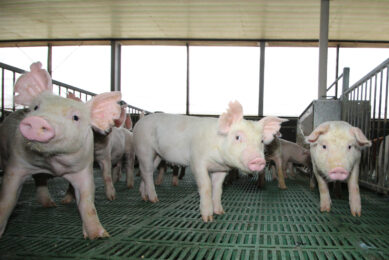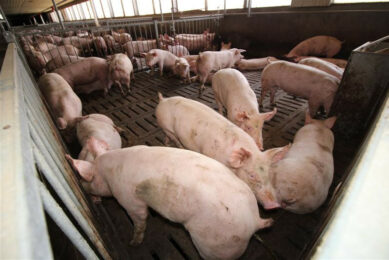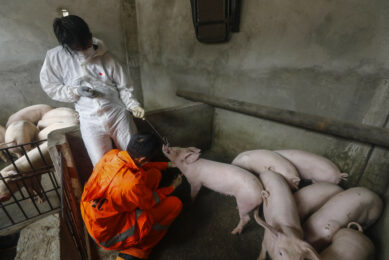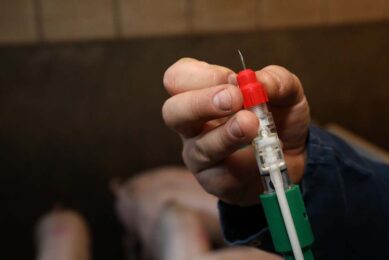Cavite Pig City: A city within a city
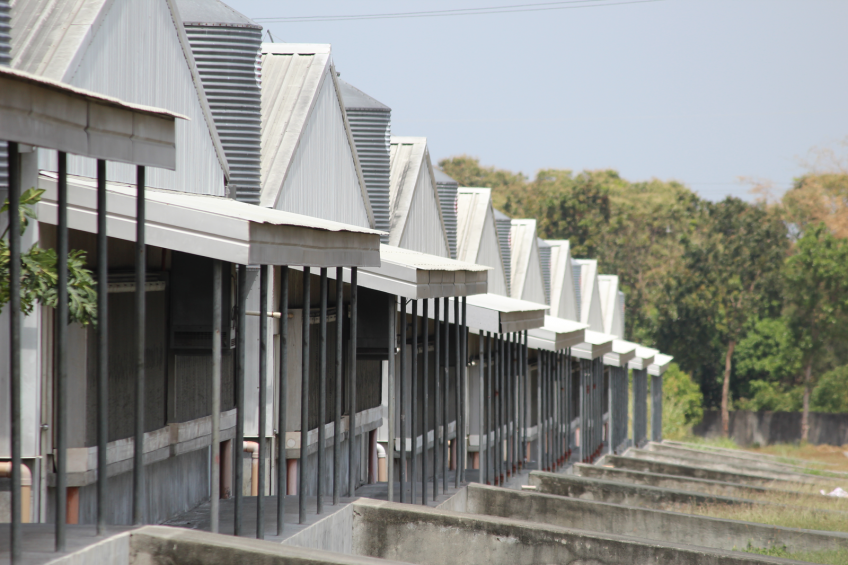
Cavite Pig City is located near General Trias, Cavite, just south of Manila. It is known for being among the top farms in the Philippines and embraces US technology to produce its pigs. The farm profits from being in the Manila vacinity – although the city is closing in.
A proper city requires proud city walls and an impressive entrance gate. Such might have been the thoughts of the owners, the Ngo family, when Cavite Pig City was constructed. Hence the main entrance overwhelmes with its height of 4 m and with its large sliding door hiding everything what is behind. Access to the farm is only granted after informing the guards of the purpose of the visit.
Once inside – and having walked through a spray of disinfectant – a true city unfolds in all its splendour. In total 121 pig houses, a feed mill, alleys with trees, headquarters, a little pavilion and even a basketball rink present itself in an area of roughly 50 hectares. The city houses a farrow-to-finish complex with 12,000 sows and with a capacity to finish 65% of the commercial pigs on-site. The other 35% is trucked away shortly after weaning to be fattened to market weight by regular client farmers.
In short, Cavite Pig City could not have named more appropriately – owner Joseph Ngo grins. He says, “It’s not only a Pig City in name – it truly is a city full of pigs.”
Farrow-to-finish operation
Joseph Ngo and his wife Vilma bought the farm in the 1990s – at the time it was a small 500 sow operation in an otherwise empty countryside.
“My family started out as feed ingredient producers,” explains Joven Ngo, the second of five children of Joseph and Vilma. The five run the farm nowadays, with their parents looking over their shoulders and having a final say in whatever is decided. Joven Ngo is in charge of planning. He continues, “In the feed ingredients business it usually took a long time between delivery and payment. When at some point we saw that demand and the prices for pigs in the Philippines became very high, we decided to start expanding in the pig business.”
The old farm was dismantled and completely redesigned. Joven Ngo says, “We started with trial and error, but eventually we even left the feed ingredients business behind us.” A fact that fills his father Joseph with pride. Asked for his secret, Joseph smiles and says: “Having a hands-on mentality, i.e. having the knowledge and being there when I needed to act. Also I used a personal touch, I’ve always stayed open to learning and have often attended exhibitions wherever I could.”
All 35 new buildings were equipped with tunnel ventilation, ideal for the tropical circumstances in the Philippines.
Modern farms
In 2015, Cavite Pig City is one of the more modern pig farms in the Philippines. An expansion in 2007-2008 tripled the size of the facility from 4,000 to the current size. All production facilities were added on the same location, using a lot of modern US technology. Where the 86 older buildings are open and flanked with trees, the 35 new buildings are all turnkey tunnel-ventilated projects, set up by climate control company Betco. This means the sides of each building are sufficiently covered, no flies can be spotted, there is a constant pleasant breeze in each of the houses.
Great for a place where average temperatures can go up to 34°C (94°F) and new style ventilation indeed does make a difference for production figures, Joven points out. “We can see the difference in weight both for the finishing pigs when they reach the marketable age as well as the weaner pigs when they are transferred.”
Another novelty in the newer barns is the automated feeding systems and silos in the new facilities, an addition supplied by US company Automated Production (AP) Systems – for sows, growers and finishers. The feed is automatically transported from silos or trucks directly into the pipe system, after which the feed is supplied to the animals.
The new buildings have all been equipped with automated feeding systems by AP Systems.
Health situation
Disease challenges mainly come from Porcine Reproductive and Respiratory Syndrome (PRRS), a growing concern in the hog industry although preventive measures are already in place, particularly, vaccinated with both European and American strains starting a few years back. PED virus has not constituted a problem on the farm. Joven states, “There were a few times we had suspicions because of outbreaks within the area, although we apply strict biosecurity measures. The clinical signs were easily treated with antibiotics and PEDv laboratory tests were negative.”
Cavite Pig City uses antibiotics, both for preventive and for treatment purposes. The major ones used are amoxicillin (against infections), tylosin (against scouring) and ivermectin (against parasites).
Gilt breeding facility
Cavite Pig City imports grandparent stock to produce its own parent stock. The farm complex uses US genetics, supplied by America’s Best Genetics, with stocks coming from reputable breeders like Waldo, Cedar Ridge, Shaffer, Tempel and Whiteshire, all registered under the National Swine Registry of the US. The female PS sows are a crossbreed of Landrace and Large White and Duroc breed is used as a terminal line.
Cavite Pig City has a total capacity for 2,800 breeding gilts at any moment. Part of the breeding gilts bred on farm are usually sold – the farm sells these for approximately 16,000 pesos (€332 or US$356) when they are five months of age. The remainder will be used on the farm for commercial production.
Gestating houses
After having been inseminated using AI, sows will be housed in gestating sow facilities with gestation crates. There are 19 sow houses in the traditional style, and six were added in the 2007-2008 expansion. The newer houses are equipped with automated feeding systems and have a capacity of 1,000 head per building.
Farrowing houses
Cavite Pig City has 12 traditional lactating sow houses and seven modern lactating sow houses. In the modern barns, Cavite Pig City has a capacity of 168 lactating sows per building. Ample attention is being paid to keep the sows cool, as the Philippines have a tropical climate year-round. Temperature management is achieved in various ways, as mentioned above, all new farm houses are equipped with tunnel ventilation. To achieve the optimum effect, at the level of the sows’ snouts, the lactating pens have an open fencing so the generated wind can blow through the pens. In addition, the sows stay on cast-iron surface which stays cooler than the plastic slats on which the piglets stay. Thirdly, the sows also have an extra drinking nipple in their troughs to be able to mix the feed with water for cooling down purposes.
The lactating sows get fed twice a day, approximately 2.5 kg every time. The piglets are weaned at 27-28 days – when they have on average a weight of 9 to 9.5 kg.
Nursery
In total there are 22 buildings for weaners, 12 original style and ten in the modern style. Not every piglet weaned will go to the grower facilities, as about 35% is sold to external finishing companies, shortly after weaning. The remaining will go to Cavite Pig City’s nursery houses.
The new series of nursery houses have a capacity of about 2,000 just-weaned piglets each. Each nursery house has two large rooms, with 16 pens on either side of the aisle of each room. They are kept in groups of approximately 30 animals and are provided with ad lib ground feed, based on soybean meal, corn, wheat and additives.
Finisher pig houses
The finisher pig houses constitute the majority of the buildings on Cavite Pig City, with 35 in original style and eight houses in the new style. The new-style finisher houses also consist of two rooms and also have a capacity of 2,000 animals. The finishers are kept in groups of approximately 20-25. Just like the grower pigs, the finishers receive an ad lib mashed feed diet based on a mixture of soybeans, corn, wheat and additives.
Since the farm applies a strict all-in all-out (AIAO) policy, all pigs go to the market simultaneously between 165-180 days of age. Where they go exactly usually depends on their weight. The heavier pigs are usually sold to meat processors – in this case their weight would ideally be around 120-130 kg liveweight. The lighter pigs are sold to local tradesmen who sell the pigs on wet markets.
Feed mill
There is a feed mill on the premises, a small one, good for about 5 tonnes per hour. This allows the farm to make its own feed for sows and smallest piglets. Feed ingredients, mostly maize, some wheat and soy, imported from Latin America, are mashed and mixed in a central tank. The feed is then directly transported to the different pig houses using the automated feeding system.
The feed for growers and finishers is made at a contract feed mill. After delivery to the farm by trucks, this is stored in the same feed mill warehouse and is then transported to the different pig houses by four on-site trucks.
Waste and biogas
Waste management plays an important role at the farm. Each manure pit underneath the houses is emptied once every three to five days. This is done by flushing the manure out into open canals. Once the pigs have left for harvest, the manure pits will be scraped off. The farm has its own biogas installation. Usually, the manure is caught and processed as fertiliser or as energy. In total, the installation can generate 1.1 MW of energy, being one of the most advanced in the Philippines. What is left over of the manure, is being used to turn into organic fertiliser. The total production time takes around 45 days.
Manila
Unintentionally, Cavite Pig City’s name also hints to what is directly outside the city’s walls: newly built modern residential areas and scattered houses with laundry hanging to dry in the sun.
When the farm was acquired and expanded in the 1990s, there was nothing of this at all – just countryside and the comfortable notion that the huge market of Manila was only 50 km away. Nowadays, however, Cavite Pig City literally feels the imminence of the country’s ever-expanding capital. Metro Manila continues to attract people from all over the country, who start living in the suburbs, gradually surrounding the farm.
So far, the Ngo family have not had any complaints from their new neighbours – probably also due to a good manure disposal policy with the wastewater treatment and biogas plant, they hope to keep it this way as long as they can. Still, another expansion like the one in 2007 is no longer possible on this site. For that reason, the Ngo family is in the process of acquiring another 65 ha piece of land in Cavite province, further away from Manila. If acquired, construction should start in 2016.
The new site should become less densely populated, Joven says, with ‘only’ 4,000 sows. Pig Progress puts forward a suggestion for a name of this second facility: Cavite Pig Park.
This farm visit has been made possible with the kind help of Mr Raul Berro, DVM.
Cavite Pig City, Philippines
Cavite Pig City, near General Trias, Cavite, Philippines, is located in Luzon, and is supplying the ever-growing market of Manila. The farrow-to-finish farm has 12,000 sows and weans 25 pigs per sow per year – very good compared to the Philippine average of 20. Piglets are weaned at 27-28 days; the average weaning weight is 9 to 9.5 kg. At slaughter, the pig’s average daily gain is 610 g; feed conversion ratio stands at 2.27.
Seen here: The Ngo family – Joven, Joseph and Vilma Ngo.



